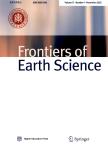Sediment transport in headwaters of a volcanic catchment Kamchatka Peninsula case study
Sediment transport in headwaters of a volcanic catchment Kamchatka Peninsula case study作者机构:Faculty of Geography M. V. Lomonosov Moscow State University Moscow 119911 Russia Department of Physical Geography and the Bolin Centre for Climate Research Stockholm University Stockholm 10691 Sweden Department of Earth and Environmental Sciences Pavia University Pavia 27100 Italy
出 版 物:《Frontiers of Earth Science》 (地球科学前沿(英文版))
年 卷 期:2017年第11卷第3期
页 面:565-578页
核心收录:
学科分类:082802[工学-农业水土工程] 090707[农学-水土保持与荒漠化防治] 0907[农学-林学] 070801[理学-固体地球物理学] 07[理学] 08[工学] 0828[工学-农业工程] 0708[理学-地球物理学] 09[农学] 0815[工学-水利工程] 0704[理学-天文学]
基 金:the project of Russian Scientific Foundation the following projects: Russian Fund for Basic research project PEOPLE MARIE CURIE ACTIONS International Research Staff Exchange Scheme Call-IRSES Fluvial processes and sediment dynamics of slope channel systems: Impacts of socio economic-and climate change on river system characteristics and related services the Swedish Research Council Formas(project)
主 题:sediment transport volcanoes lahars Kam-chatka Peninsula MUSLE erosion
摘 要:Due to specific environmental conditions, headwater catchments located on volcanic slopes and valleys are characterized by distinctive hydrology and sediment transport patterns. However, lack of sufficient monitoring causes that the governing processes and patterns in these areas are rarely well understood. In this study, spatiotemporal water discharge and sediment transport from upstream sources was investigated in one of the numerous headwater catchments located in the lahar valleys of the Kamchatka Peninsula Sukhaya Elizovskaya River near Avachinskii and Koryakskii volcanoes. Three different subcatchments and corresponding channel types (wandering rivers within lahar valleys, mountain rivers within volcanic slopes and rivers within submountain terrains) were identified in the studied area. Our measure- ments from different periods of observations between years 2012-2014 showed that the studied catchment was characterized by extreme diurnal fluctuation of water discharges and sediment loads that were influenced by snowmelt patterns and high infiltration rates of the easily erodible lahar deposits. The highest recorded sediment loads were up to 9-104 mg/L which was related to an increase of two orders of magnitude within a one day of observations. Additionally, to get a quantitative estimate of the spatial distribution of the eroded material in the volcanic substrates we applied an empirical soil erosion and sediment yield model - modified universal soil loss equation (MUSLE). The modeling results showed that even if the applications of the universal erosion model to different non-agricultural areas (e.g., volcanic catchments) can lead to irrelevant results, the MUSLE model delivered might be acceptable for non-lahar areas of the studied volcanic catchment. Overall the results of our studyincrease our understanding of the hydrology and asso- ciated sediment transport for prediction of risk manage- ment within headwater volcanic catchments.



